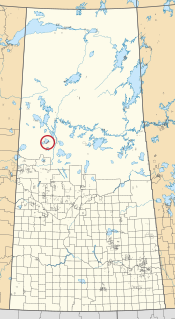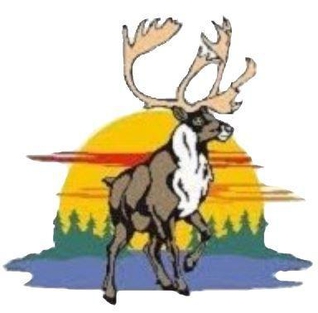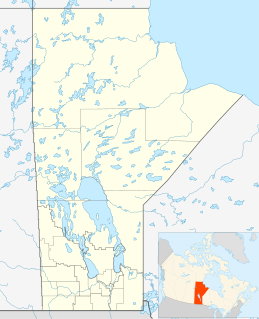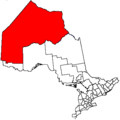Treaty 3 was an agreement entered into on October 3, 1873, by Chief Mikiseesis on behalf of the Ojibwe First Nations and Queen Victoria. The treaty involved a vast tract of Ojibwe territory, including large parts of what is now northwestern Ontario and a small part of eastern Manitoba, to the Government of Canada. Treaty 3 also provided for rights for the Waasaakode Anishinaabe and other Ojibwe, through a series of agreements signed over the next year. The treaty was modified in 1875 when Nicolas Chatelain negotiated an adhesion that created a reserve, surveyed as reserve 16A, for Metis families connected to Mikiseesis' Rainy Lake Band. Reserve 16A and the Rainy Lake Band reserve were unified in 1967.

The Flying Dust First Nation is a Cree First Nation band government located adjacent to the city of Meadow Lake in Saskatchewan, Canada. Highway 55 goes through the band's reserve community.

Aroland First Nation is an Ojibwa and Oji-Cree First Nation within the Nishnawbe Aski Nation Territory and a signatory to Treaty 9, located in the Thunder Bay District approximately 20 kilometres west of Nakina. Aroland First Nation, has Indian reserve status, though the settlement itself is not a reserve. The Aroland First Nation is also a member of the Matawa First Nations Tribal Council.

Wawakapewin First Nation is an Oji-Cree First Nation reserve located 350 kilometers north of Sioux Lookout, Ontario. It is only accessible by air and the winter road system from Pickle Lake. It is a small community in which the registered population in June 2013 was 73, of which 43 lived on their own Reserve. The current Chief is Anne-Marie Beardy. Wawakapewin First Nation is a member of Shibogama First Nations Council.

North Spirit Lake First Nation is a small Oji-Cree First Nation reserve in Northern Ontario, located north of Red Lake, Ontario. It is connected to Sandy Lake First Nation, and Deer Lake First Nation by winter/ice roads. It is part of the Keewaytinook Okimakanak Council and the Nishnawbe Aski Nation.

Keewaywin is a small Oji-Cree First Nation band government in Northern Ontario, located north of Red Lake, Ontario. It is connected to Sandy Lake First Nation by Sandy Lake. It is part of the Keewaytinook Okimakanak Council and the Nishnawbe Aski Nation. Sandy Lake First Nation Band members separated from Sandy Lake First Nation to form Keewaywin First Nation. The Indian reserve is entirely surrounded by territory of the Unorganized Kenora District.

Canoe Lake 165 is an Indian reserve of the Canoe Lake Cree First Nation in the boreal forest of northern Saskatchewan, Canada. Its location is on Canoe Lake approximately thirty miles west of Beauval, within the ancient hunting grounds of the Woodland Cree. In the 2016 Canadian Census, it recorded a population of 912 living in 250 of its 273 total private dwellings. In the same year, its Community Well-Being index was calculated at 53 of 100, compared to 58.4 for the average First Nations community and 77.5 for the average non-Indigenous community. The reserve includes the settlement of Canoe Narrows.
Fort McMurray First Nation is a Cree and Chipewyan band government located near Fort McMurray, Alberta. It is a member of the Athabasca Tribal Council and a Treaty 8 nation. The Athabasca Tribal Council represents 5 First Nation bands in northeast Alberta. Fort McMurray First Nation is governed by a Chief and two councillors.

The Ojibway Nation of Saugeen is an Ojibwa First Nation in the Canadian province of Ontario. The Nation is located in the Thunder Bay District, approximately 20 kilometres northwest of Savant Lake. In December, 2007, its total registered population was 206, of which the on-reserve population was 72. The community maintains strong ties with Mishkeegogamang First Nation

The Mattagami First Nation is an Anishnaabe First Nation band government - mainly Ojibwe, Oji-Cree and some Odawa - in the Canadian province of Ontario situated along the Mattagami River. The First Nation members of the community primarily live on the Mattagami 71 reserve in the Sudbury District near Gogama. The on-reserve population is approximately 100 residents.
Grand Council of Treaty 3 (GCT3) is a political organization representing 24 First Nation communities across Treaty 3 areas of northern Ontario and southeastern Manitoba, Canada, and four additional First Nations, specifically in regard to their Treaty rights.

The Biinjitiwaabik Zaaging Anishinaabek is an Ojibway First Nation band government in Northwestern Ontario, Canada. Their territory is located on the Rocky Bay 1 reserve in Greenstone, Ontario, bordering on the community of Macdiarmid. In October 2008, they had a total registered population of 678 people, of which 327 people lived on their own Indian reserve. The Nation is led by Chief Melvin Hardy. The council is a member of Nokiiwin Tribal Council, a Regional Chiefs' Council, and is member of Union of Ontario Indians, a Tribal Political Organization. The First Nation is also a member of Waaskiinaysay Ziibi Inc., an economic development corporation made up of five Lake Nipigon First Nations.

Flying Post First Nation is an Ojibway and Cree First Nation band government in Nipigon, Ontario. It has a reserve called Flying Post 73.

Hatchet Lake Denesuline Nation is a Denesuline First Nation in northern Saskatchewan. The main settlement, Wollaston Lake, is an unincorporated community on Wollaston Lake in the boreal forest of north-eastern Saskatchewan, Canada.

Sandy Bay First Nation is an Ojibway/mixed-blood First Nation in Manitoba, Canada. As of the 2016 Canadian Census, it had a population of 2,515; while the First Nation's website reports a membership of 6,776 individuals as of April 2018.

Matachewan First Nation is an Ojibway and Cree First Nation reserve located in the Timiskaming District of Ontario, Canada. As of March, 2012, they had a total registered population of 642 people, of which 40 people lived on their own reserves.

Montreal Lake Cree Nation is a Woodland Cree First Nation in the boreal forest of central Saskatchewan, Canada. Its reserve, Montreal Lake 106, is on the southern shore of Montreal Lake 103 km (64 miles) north of Prince Albert and 167 km (104 miles) south of La Ronge. Highway 969 passes through the village.
Bimose Tribal Council is a First Nations council, one of three such councils on the Grand Council of Treaty 3. Its members include:

Peepeekisis Cree Nation is a Cree First Nation in southern Saskatchewan, Canada. Its reserves include Peepeekisis 81; Treaty Four Reserve Grounds 77, which is shared with 32 other bands; and Peepeekisis First Nation, which is located 19 km (12 mi) east of Balcarres, Saskatchewan, on Highway 10.
The Statistical Center of Iran is the main organization for statistics in Iran. It is administered and funded by the Government of Iran.










